Written by Beth Nagel, SDSU College of Agriculture, Food, and Environmental Sciences undergraduate student, under the direction and review of Kristine Lang, Assistant Professor, and Rhoda Burrows, former Professor & SDSU Extension Horticulture Specialist. Special thanks to Rebekah White and Zoey Stefanich for peer review of this article.
Introduction to Rhubarb
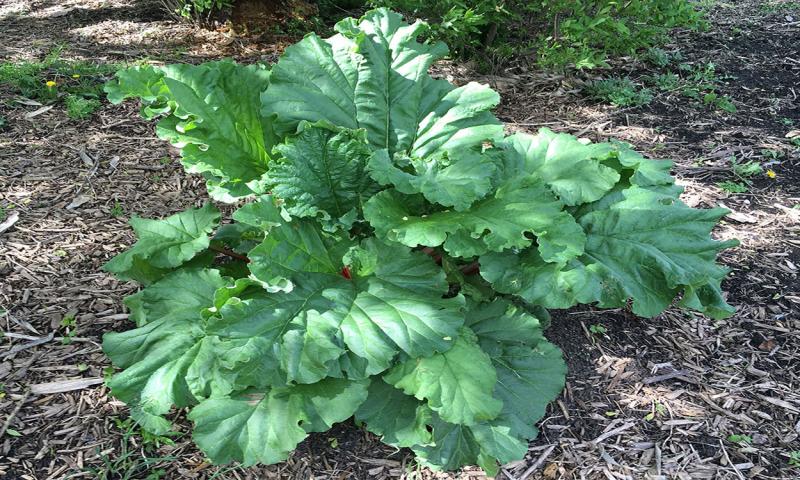
Rhubarb is a cool-season, herbaceous perennial in the Polygonaceae family. Rhubarb is botanically a vegetable, but it is used as a fruit. Rhubarb is commonly grown for its edible leafstalks or petioles, which can grow up to 18 inches long and one to two inches in diameter. A mature rhubarb plant can grow two to four feet tall and occupy six square feet of space. The tart leafstalks are commonly used for baking or jams and jellies; they are also used for wine. Special care should be taken to avoid ingestion of the leaves, however, as they contain a toxic amount of oxalic acid, a poisonous substance. According to the 2017 Census of Agriculture, there are 20 farms harvesting nine acres of rhubarb in South Dakota. Rhubarb is commonly grown outdoors, but may be grown in greenhouses, especially for forcing – a method of obtaining an earlier crop. Listed below are several common rhubarb varieties along with their properties:
Rhubarb Varieties
Crimson Cherry
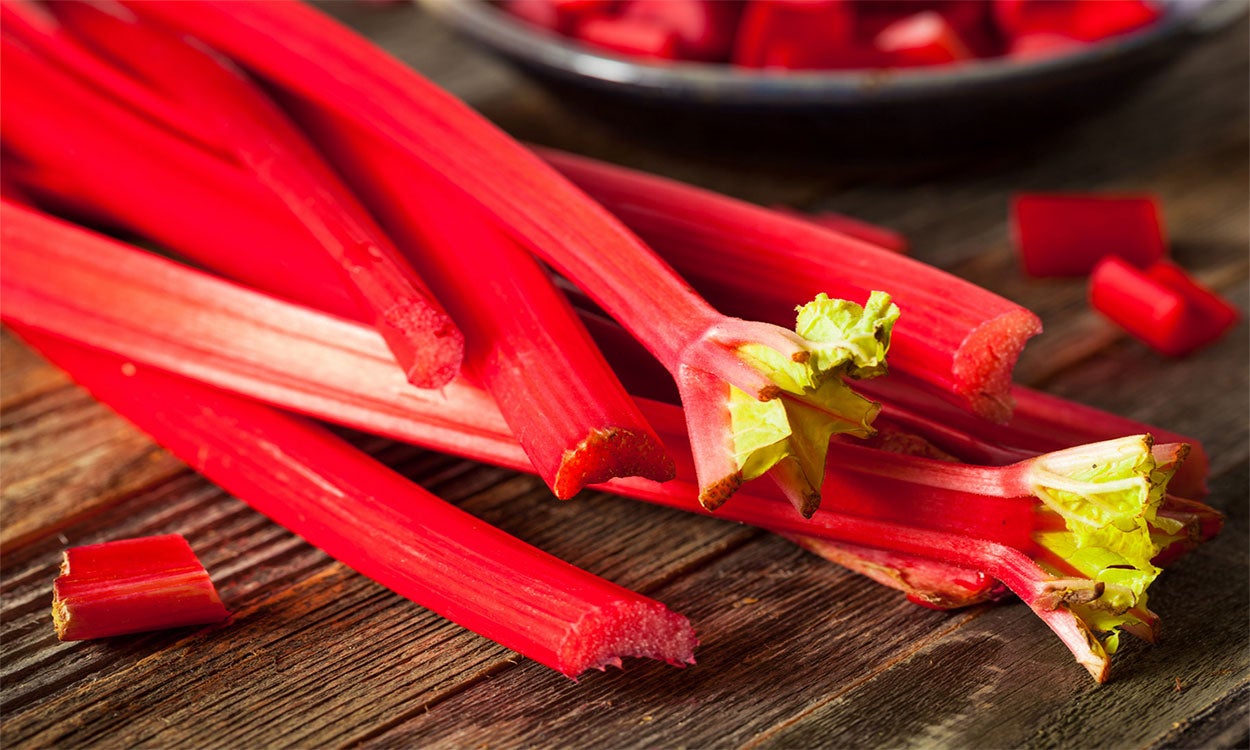
Known for its vibrant color. Rich, red exterior and interior.
Victoria
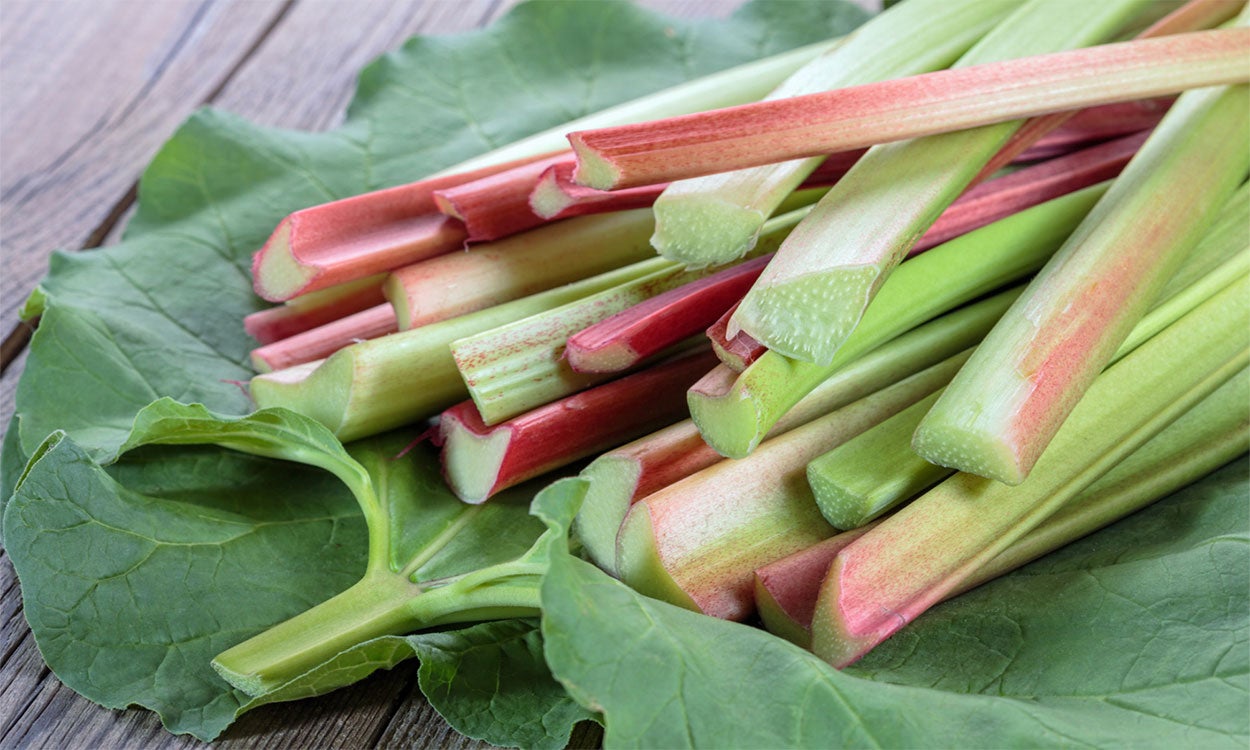
Medium stalks, light-green speckled with pink.
Canada Red
Sweet, few seedstocks.
MacDonald
Tender skin, bright red.
Valentine
Broad stalks, less acidic, few seedstocks.
Managing Rhubarb Quality
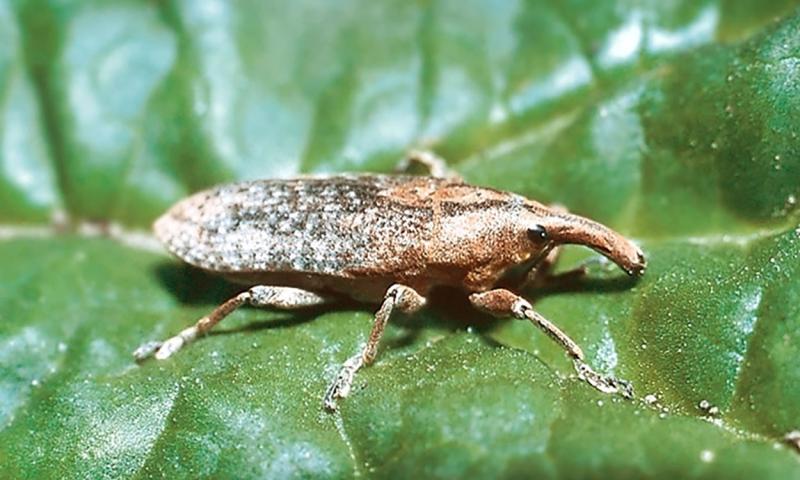
Rhubarb should be planted in full sun in well-drained soil with high organic matter content. The intake of nutrients in rhubarb is high, so fertilizer should be supplemented each year in early spring and after harvest in late June. Mulch use may be beneficial in moderating soil temperature and moisture.
Pests
There are not many insect pests that are overly problematic for rhubarb. Insects to be aware of for potential damage include the rhubarb curculio and stalk borers. Managing surrounding weeds will help control these insects.
Diseases
Leaf spot is the most-common disease; minimize the disease by removing infected leaves after the first hard fall frost. If the site stays too moist, root rots may invade.
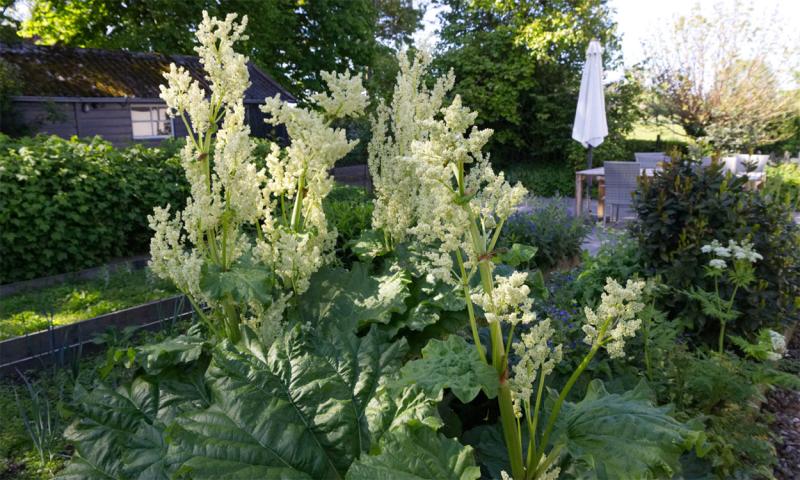
Flower Stalks
Production of flower stalks is fairly common under certain environmental conditions; these should be cut off to sustain and direct plant energy for crop production. Consider selecting varieties with fewer flower stalks as a preventative measure.
When to Harvest Rhubarb
Rhubarb should not be harvested the first year of planting in order to allow root growth and establishment; If started from seed, allow a second year of development prior to harvest. Minimized harvest can begin in the second or third year of growth, and full harvest during the fourth. Harvest for two to four weeks during the first year of minimized harvest and eight to ten weeks for full harvest, beginning in the spring and harvesting through the end of June. Only harvest in the fall when the plant will no longer be used for production the following season. A late harvest or overmature stalk may become pithy, or spongy.
How to Harvest Rhubarb
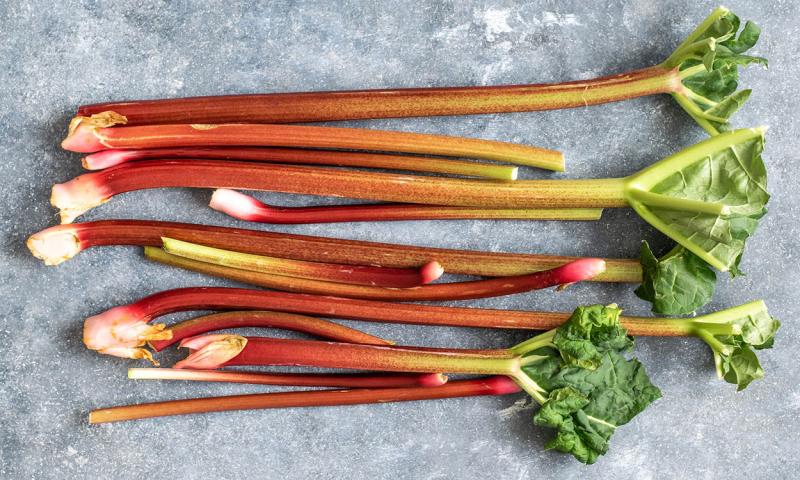
Rhubarb is harvested by pulling and twisting the leafstalk from the stem at the base. The leafstalks should not be cut, as that may provide a disease entry point. Only one-third to one-half of the leafstalks should be harvested from the plant to ensure continual production and vigor. Once the stalks have been harvested from the plant, remove the leaves with a clean, sharp knife and properly dispose of them by composting. Rhubarb is often bunched when harvesting. Consumer self-serve picking may be beneficial to reduce labor requirements. For immediate use or processing, both ends of the petiole should be trimmed to remove all the leaf tissue. For market, leave ¼ inch of leaf tissue and do not cut the basal end to maintain stalk freshness and prevent splitting.
Cleaning Rhubarb
Rhubarb may first be field cleaned after harvesting by brushing off any noticeable dry soil or debris. When preparing to clean rhubarb, be sure that any equipment or surfaces that will touch the crop is properly cleaned and sanitized, including hands. Rhubarb should be cleaned off with single-pass water to remove any dirt or debris and air-dried. It is not consumed raw, so removing visible contaminants is the most-important factor in cleaning rhubarb.
Sorting and Marketability of Rhubarb
Three USDA standards exist for fresh rhubarb, which include the following:
U.S. Fancy
- Very well-colored, fresh, tender, straight, clean, well-trimmed and not pithy.
- Free from decay and damage caused by scars, freezing, disease, insects, or mechanical or other means.
- Stalk diameter is greater than one inch and length greater than ten inches.
U.S. No. 1
- Well-colored, fresh, tender, straight, clean, well-trimmed and not pithy.
- Free from decay and damage caused by scars, freezing, disease, insects or mechanical or other means.
- Stalk diameter is greater than ¾ inch and length greater than ten inches.
U.S. No. 2
- Fairly well-colored, fresh, fairly straight, clean, well-trimmed and not pithy.
- Free from decay and serious damage caused by scars, freezing, disease, insects or mechanical or other means.
- Stalk diameter is greater than ½ inch and length greater than eight inches.
Harvest and Post-harvest Food Safety
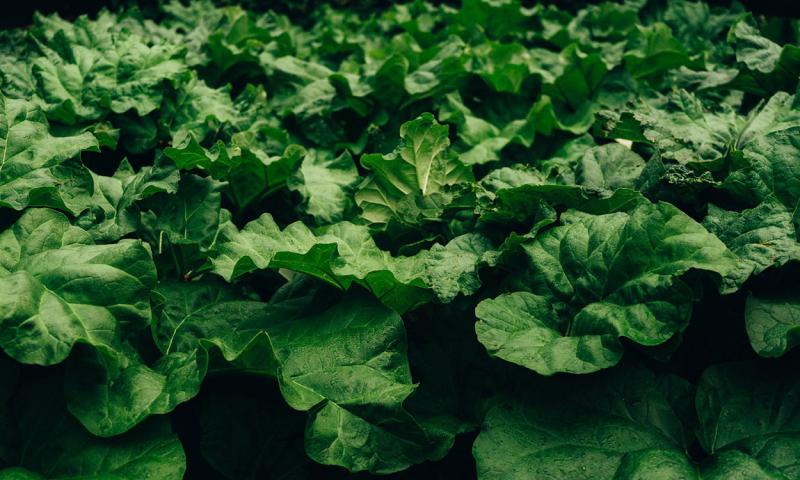
The biggest food safety concern to manage for rhubarb is ensuring that leaves do not get consumed by humans or pets. Rhubarb leaves contain a toxic amount of oxalic acid, which is poisonous and can cause nausea, vomiting, and, in severe cases, death. Rhubarb growers should also take note of any withering or discoloring on leaves after a hard frost, as the oxalic acid may travel through the stalks after a freeze. Any damaged leaves or stalks should be removed after a frost. Rhubarb is commonly consumed cooked, so proper cooking or baking methods should prevent any foodborne illnesses. The concave shape of the petioles could potentially hold debris or contaminants; special care should be taken to make sure the crop is clean before consumption. Rhubarb also has a porous inside, so damaged crops should be discarded to avoid pathogen entry and ingestion.
On-Farm Storage of Rhubarb
Rhubarb should be stored at 32 degrees Fahrenheit and 95 to 100% relative humidity. Fresh stalks may be stored two to four weeks in these conditions. When storing, rhubarb should be cooled to 32 degrees within one day of harvest. This can be done using hydro-cooling or air-cooling. Hydro-cooling can be done by moving chilled water over the produce. Air-cooling forces cool air into a cool room and pulls the air over produce. Stalks or bunches should be packed in crates with abundant air circulation. Consider lining crates with a perforated polyethylene film to retain moisture.
Marketing Rhubarb
Consumer self-picking is popular for marketing rhubarb due to the labor intensity of harvesting. Rhubarb is especially popular for baking because of its tart stalks, but it has several additional uses. It is great for pie fillings, crisps, sauces, juice, or wine. Rhubarb will preserve and freeze easily, so it can be enjoyed far past the fresh rhubarb season. Although commonly grown for its edible stalks, rhubarb also makes a great ornamental plant with its large leaves and bright petioles. Scientists and health professionals have recently begun looking into various health benefits of rhubarb for medical use, including antibacterial, anti-inflammatory, and antifibrotic properties and gastrointestinal function regulation.
References
- Boswell, V. R. Rhubarb Production Outdoor and In. Vol. 354, U.S. Department of Agriculture. 1966.
- How to pick rhubarb. Sanderson Gardens. May 17, 2020.
- Klass, C., Muka, A. Rhubarb Curculio. Cornell University Insect Diagnostic Laboratory. July 2014.
- Mahr, S. Rhubarb, Rheum Rhabarbarum. Wisconsin Horticulture Division of Extension. Retrieved November 21, 2022.
- Marquesen, S. Rhubarb: Be Patient and You Will Be Rewarded. PennState Extension. May 14, 2019.
- Rhubarb Seed Stalks…What to Do. Sanderson Gardens, May 24, 2020.
- Rhubarb. Oregon State University Extension Service. August 2004.
- U.S. Census of Agriculture. United States Department of Agriculture. 2017.
- United States Standards for Grades of Rhubarb (Field Grown). United States Department of Agriculture. September 6, 2016.
- Watch Your Garden Grow. University of Illinois Extension. Retrieved November 21, 2022.
- Weisenhorn, J. Plant Some Rhubarb. University of Minnesota Extension. May 19, 2022,
- Xiang, H., Zuo, J., Guo, F., Dong, D. What We Already Know About Rhubarb: A Comprehensive Review. Chinese Medicine. August 26, 2020.


